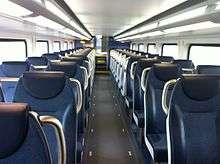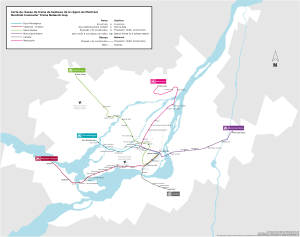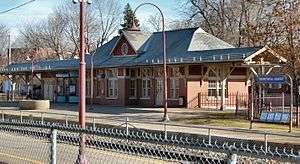Agence métropolitaine de transport
 | |||
|
An outbound train on the Mont-Saint-Hilaire Line | |||
| Overview | |||
|---|---|---|---|
| Locale | Greater Montreal | ||
| Transit type |
Commuter rail Express bus service | ||
| Number of lines | 6 | ||
| Number of stations |
61 rail (2 planned) 19 bus[1] | ||
| Daily ridership |
86,100 (all modes)[2] - 79,700 (train) - 6,400 (bus) | ||
| Annual ridership | 19,322,200 (2014)[3] | ||
| Chief executive | Paul Côté | ||
| Headquarters | 700 rue de la Gauchetière, Montreal, Quebec, Canada | ||
| Website | AMT.qc.ca | ||
| Operation | |||
| Began operation | January 1, 1996 | ||
| Operator(s) | Montrain | ||
| Reporting marks | AMT | ||
| Number of vehicles |
50 locomotives 206 coaches [1] | ||
| |||
The Agence métropolitaine de transport (AMT; English: Metropolitan Transportation Agency) (reporting mark AMT) is the umbrella organization that plans, integrates, and coordinates public transportation services across Canada's Greater Montreal Region, including the Island of Montreal, Laval (Île Jésus), and communities along both the North Shore of the Rivière des Mille-Îles and the South Shore of the St. Lawrence River. It was created on December 15, 1995 by the Loi sur l'Agence métropolitaine de transport (English: AMT Act) and took over from the STCUM's commuter rail service on January 1, 1996. The AMT operates Montreal's commuter rail and express bus services, and is the second busiest such system in Canada after Toronto's GO Transit.
AMT's territory spans 63 municipalities and one native reserve, 13 regional county municipalities, and 21 transit authorities. It serves a population of approximately 4.1 million people who make more than 750,000 trips daily in the 4,258.97 km2 (1,644.40 sq mi) area radiating from Montreal.
AMT's mandate includes the management of reserved bus lanes as well as HOVs on the A-15 north of the A-40, metropolitan terminuses, park-and-ride lots, and a budget of $163 million, which is shared amongst the transit corporations and inter-municipal public transit organizations. Apart from these essential services, AMT is also responsible for Montreal's commuter rail service, which links the downtown core with communities as far west as Hudson, as far east as Mont-Saint-Hilaire, and as far north as Saint-Jérôme.
In 2014, the AMT ranked first among commuter rail agencies in North America with a punctuality rate of 96.6%, trailed by Chicago's Metra, New Jersey's New Jersey Transit and Minneapolis' Northstar.[3]
Partners in transport
The main partners in transport are 14 transit agencies:[4]
- 3 public transport agencies: Réseau de transport de Longueuil (RTL) / Société de transport de Laval (STL) / Société de transport de Montréal (STM)
- 9 intermunicipal boards of transport (CIT): CIT Chambly-Richelieu-Carignan / CIT de la Vallée du Richelieu / CIT du Haut-Saint-Laurent / CIT du Sud-Ouest / CIT La Presqu'Île / CIT Laurentides / CIT Le Richelain / CIT Roussillon / CIT Sorel-Varennes
- 1 regional transport board (CRT): CRT Lanaudière
- 1 municipality that organizes its own public transit service: the town of Sainte-Julie
Commuter rail

The AMT's commuter trains are its highest-profile division. It has two types of trains: electric multiple unit (EMU) trains, used on the Deux-Montagnes Line, and diesel-electric push-pull trains, used on all the others. The Deux-Montagnes line was electrified because of the 4.8 km (3 mi) long poorly ventilated tunnel to Central Station. Diesel trains through the tunnel were at one time restricted and are now prohibited; the diesel-powered trains of AMT's Mont-Saint-Hilaire line, Via Rail and Amtrak all arrive at Central Station from the direction opposite the tunnel.
The AMT commuter trains operate on tracks owned by Canadian National, Canadian Pacific and Quebec Gatineau Railway. The Mont-Saint-Hilaire line run on CN trackage and operate out of Central Station, while the Vaudreuil-Hudson, Saint-Jérôme, and Candiac lines run on CP trackage and operate out of Lucien L'Allier terminus, beside the historic Windsor Station. The Saint-Jérôme line also runs on Quebec Gatineau Railway trackage and on the AMT's own trackage between Sainte-Thérèse and Saint-Jérôme. The Deux-Montagnes line, including trackage and all infrastructure, as well as the Mount-Royal tunnel, is also fully owned by the AMT.[5]
The train lines are integrated with the bus and Metro network maintained by the Société de transport de Montréal (STM). The AMT bus and train operations are currently being given to the Réseau de Transport Métropolitain (reporting mark RTM).
List of commuter train lines
| Train Lines | Line length | AMT service inaugurated | Electrified |
|---|---|---|---|
| 62.8 km (39.0 mi) | July 1997 | No | |
| 25.6 km (15.9 mi) | September 4, 2001 | No | |
| 29.9 km (18.6 mi) | January 1, 1996 | Yes | |
| 51.2 km (31.8 mi) | January 1, 1996 | No | |
| 34.9 km (21.7 mi) | 2000 | No | |
| 52 km (32 mi) | December 1, 2014 | Only from Central Station to Ahuntsic Station[6] |
Fares
The greater Montreal area is divided into 8 fare zones. Starting from downtown Montreal, they stretch outwards in all directions. The first three zones are within the cities of Montreal, Laval and Longueuil only. The commuter train fare system is based on the assumption that the user is travelling to or from downtown. It is the same price, for example, to travel within zone 3 or from zone 3 to zone 2 as opposed to travel from zone 3 to zone 1.
To use the train, passengers must have a validated TRAM or TRAIN fare that covers the furthest zone travelled. TRAM fares provide access to the Montreal Metro and buses within the fare zone without any additional payment while the TRAIN fares are only valid on commuter trains. Tickets can be purchased individually or in a six-trip card Single and 6-trip TRAM fares are available for zones 1, 2, and 3 only, and are valid only on STM buses. Regular users can get a monthly pass if they have an OPUS card. Tickets and passes for commuter trains are valid for any line, as long as the ticket is used within 120 minutes from the time of purchase or validation. Travel is limited to the zone for which the ticket is purchased, or any lower-numbered zone, but not a higher-numbered one. For example, a zone 5 ticket is valid for zones 1, 2, 3, 4, and 5, but not zones 6, 7, and 8. Local bus tickets and passes are not valid on commuter trains. There are no faregates; instead, fare inspectors randomly check tickets.
All fares are available in a cheaper "reduced" category for children 6 to 15 years old, students 16 and 17 years old, and seniors that are 65 or older. Additionally, monthly passes are available in a "student" category (which is cheaper than the regular fare but more than the reduced fare) for students 18 to 25 years old. To benefit from the reduced or student fares, the passenger must have a reduced-fare OPUS card with their name and photo on it. Travel on the commuter trains is free for anyone 5 and under as well as children 6 to 11 years old travelling with an adult.
Following the introduction of the OPUS, smart card system tickets and passes are now sold by automated vending machines at each station. The machines accept cash, credit and debit cards. Purchases of more than $80 must be paid by cards. Tickets and passes are also sold at a few stores near the suburban stations. Consult the full list on the AMT's website.[7][8] Passes are valid for a calendar month, and are normally on sale from the 20th of the previous month to the 5th of their month of validity. Passengers can also subscribe to OPUS+ which automatically debits the passenger's bank account or credit card and adds the pass to the passenger's OPUS card.
Locomotives and passenger vehicles
The AMT has a variety of rolling stock, some of it acquired from GO Transit, the rest built specifically for the AMT. There are total of 256 cars and locomotives in the fleet.
Locomotives

| Maker | Model | Number in Service | Numbered | Comments |
|---|---|---|---|---|
| General Motors | F59PHI | 11 | 1320-1330 | Used on the Vaudreuil-Hudson Line and Saint-Jérôme Line, sometime used on the Candiac line. |
| General Motors | F59PH | 10 | 1340-1349 | Acquired from GO Transit. Used on the Candiac Line, are used on Vaudreuil-Hudson and Mont-Saint-Hilaire Lines. Some of them are undergoing refurbishments and repainting. |
| Bombardier | ALP-45DP | 20 | 1350-1369 | Used on Mont-Saint-Hilaire, Vaudreuil-Hudson and Saint-Jérôme Lines; are now also used on Deux-Montagnes and Mascouche Lines.[9] |
| Bombardier | MR-90 | 58 | 400s | Single-level electric multiple unit used exclusively on the Deux-Montagnes Line. |



Passenger cars
- Current push-pull train coaches
- 160 multi-level coaches built between 2008 and 2011 by Bombardier Transportation (similar to NJ Transit's multilevel fleet)[10]
- 24 single-level coaches; Built in 1989 by Bombardier Transportation (similar to NJ Transit's Comet II and Metro-North's Shoreliner I fleet)
- 22 bilevel coaches; Built in 2004 by Bombardier Transportation
- Retired Coaches
- 80 single-level coaches (originally from GO Transit); Built between 1967 and 1976 by Hawker-Siddeley Canada; retired following the arrival of the 160 multi-level cars.
- 9 Canadian Vickers gallery cars (rebuilt from June 2005 to December 2006).
The 58 Bombardier electrics are exclusively used on the Deux-Montagnes Line These are numbered in the 400s, and operate in married pairs (as only one car in each pair has motors).
The 22 bilevel coaches are in operation on the Saint-Jérôme Line. The AMT did not purchase additional bilevels as it sought to standardize its train fleet with the arrival of the multi-level coaches.
On December 18, 2007, the AMT awarded Bombardier a $386-million contract to build 160 multi-level commuter cars. These cars will be based on the multilevel series of NJ Transit, as opposed to the recent purchase of GO-style bilevel cars, and will be able to enter the Mount Royal Tunnel. NJ Transit has a similar technical requirement; Bombardier designed the cars to enter the North River Tunnels between NJ and NYC. They are numbered in the 3000s.
History
Canadian National (CN) and Canadian Pacific (CP) had long operated commuter trains in the Montreal area, but by the 1980s, their services had dwindled to one route each. The Société de transport de la communauté urbaine de Montréal (STCUM), or Montreal Urban Community Transportation Corporation (MUCTC), which already managed Metro and bus services across the Island of Montreal, assumed management of CN's Deux-Montagnes commuter service and CP's Rigaud service in 1982 as the two railways began scaling back their services.
In 1997, management and financing of both lines was transferred to the newly created AMT, which had been established to distribute funding and coordinate transportation planning among the numerous transit operators throughout the Greater Montreal Region. Later that year, the AMT inaugurated service between Blainville and Jean-Talon (now Parc) train station in Montreal's Park Extension district, connecting to the Metro at Parc . Originally, the service was designed to provide a temporary alternative for motorists from Laval and the North Shore of Montreal, while the Highway 117 Dufresne Bridge was being repaired. The service proved to be so popular that the AMT continued to fund it, and even extended a number of trains to the Lucien-L'Allier station downtown in 1999, and continues to provide off-peak daytime weekday service on this line. The service was extended further north to Saint-Jérôme in 2007.
In 2000, AMT inaugurated its service to McMasterville (which runs along a CN line), and later extended it to Mont-Saint-Hilaire in 2002.
In 2001, the AMT initiated a pilot project, launching service on a fifth line (using CP tracks) to Delson. This was later extended to Candiac in 2005. More information about the history of each line can be found in their respective articles.
In 2014, the AMT acquired the entire Deux-Montagnes line from CN, including the right of way, infrastructure, trackage, other railway equipment, grounds, curb lanes, rights in the Mount Royal tunnel and air rights, in a $97 million transaction.[5]
Buses
The AMT runs one Metropolitan Express Bus.
- Express Chevrier 90, also called Express Terminus Centre-Ville 90 — operated by the RTL in Longueuil (using Van Hool AG300 buses) and links the Brossard-Chevrier Park and Ride in Brossard to the Downtown Terminus.
The AMT runs one Trainbus.
- Trainbus 935, also called Trainbus Blainville/Centre-ville 935- operated by the STM in Montreal and links Parc Metro station to Lucien-L'Allier AMT station.
Park and ride
The AMT also is responsible for all Park and ride lots in the greater Montreal region. It runs 61 park-and-ride lots,[11] many that are connected to either metropolitan bus terminuses, STM Metro stations, or AMT commuter rail stations.
In addition, the agency also organizes carpooling, offering unloading spaces near public transit services in several of its park-and-ride lots, which allow for transfers to the bus, Metro or commuter train.[12]
Ridership
In 2014, the AMT carried 86,100 passengers on a typical weekday — 79,700 on the trains and 6,400 by bus.[2]
| Number of Passenger Trips (2014)[3] | |||
|---|---|---|---|
| Rail lines | |||
| Deux-Montagnes Line | 7,675,000 | ||
| Vaudreuil-Hudson Line | 3,763,500 | ||
| Saint-Jérôme Line | 2,863,800 | ||
| Mont-Saint-Hilaire Line | 2,303,100 | ||
| Candiac Line | 1,077,300 | ||
| Subtotal — Rail lines | 17,786,700 | ||
| Bus routes | |||
| AMT Express Bus Service | 1,535,500 | ||
| Total — AMT System | 19,322,200 | ||
Future projects
Vision 2020 Strategic Plan
In its Vision 2020 Strategic Plan, the AMT plans to focus on improving its current commuter rail lines. No new line is expected before 2020. The AMT will focus on eight major public transportation projects for the Montréal area:[13]
- Metro extensions: Extending the Orange, Yellow and Blue lines. A project office is currently studying extensions of the Blue line to the Montréal boroughs of Saint-Léonard and Anjou, the Orange line to the suburb of Laval, passing through the Montréal borough Saint-Laurent, and the Yellow line into Longueuil,
- Building the South Shore Line rapid transit service over the new Champlain Bridge, currently in planning.
- Electrification of its commuter rail lines. Currently, only the Deux-Montagnes line runs on electricity.
- A bus rapid transit (BRT) system on Pie-IX boulevard. The BRT will include two dedicated bus lanes in the middle of Pie-IX Boulevard from Laval to Montréal and include 21 stations and three park-and-ride lots.
- Increasing capacity of the Terminus Centre-Ville (Downtown Bus Terminal), mainly serving South Shore buses.
- Build the Train de l'Ouest light rail line with connection to Montréal-Pierre Elliott Trudeau International Airport.
- Build maintenance centres in Lachine and Pointe-Saint-Charles. The two sites will allow the AMT to maintain and store (between peak hours) its train cars and locomotives. The Lachine site will accommodate rolling stock running on Canadian Pacific tracks and the Pointe-Saint-Charles site will accommodate trains running on Canadian National tracks.
- Increasing capacity in the Mont Royal Tunnel. To increase service on the Deux-Montagnes Line and accommodate the Mascouche Line, the AMT must carry out important infrastructure work to make the tunnel safer.
Deux-Montagnes Line
Main projects:
- Since 2010, the AMT has been building a railway overpass for commuter trains to pass below freight trains that currently use CN's Saint-Laurent subdivision just south of the Montpellier station. The overpass is a prerequisite to increase commuter train frequencies on the Deux-Montagnes line as well the commissioning of the Mascouche Line. The $60-million project should be completed by early 2014, when the new line is also expected to be commissioned.[14]
- Extend the double track from its current end point at the Bois-Franc station to the Roxboro-Pierrefonds station in Pierrefonds-Roxboro. Work includes doubling the track over 7.5 km parallel to the existing track, rebuilding a small bridge, building a new overpass over the bike path through Bois-de-Liesse park, reconfiguring three level crossings, and adding a second platform at Sunnybrooke station. Construction should begin in 2013 and be complete by 2015. Preliminary costs are estimated at $51 million.[15][16]
Vaudreuil-Hudson Line
To increase service on the Vaudreuil-Hudson Line, there are plans to add dedicated tracks for commuter trains. The current tracks are used by the AMT under the permission from Canadian Pacific. On July 1, 2010, service to Rigaud was discontinued, due to Rigaud's reluctance to pay annual fees; the rail line now ends at Hudson.[17]
Candiac Line
The possibility of extending the Candiac Line to Saint-Jean-sur-Richelieu is currently being examined by the Quebec Government, and a study on the project will start in 2014.
References
- 1 2 "Programme Triennal d'Immobilisations 2011/2012/2013" (PDF) (in French). Agence métropolitaine de transport. 2010-11-12. Retrieved 3 October 2011.
- 1 2 AMT Rapport d'activité 2012 (French, p.7)
- 1 2 3 https://www.amt.qc.ca/Media/Default/pdf/section8/publications/amt-rapport-annuel-2014.pdf
- ↑ AMT, The Main Players in Transport: 14 transit agencies
- 1 2 L’AMT FAIT L’ACQUISITION DE LA LIGNE DE TRAINS DE BANLIEUE DEUX-MONTAGNES (In French)
- ↑ amt.qc.ca - Projected Route
- ↑ Tarifs
- ↑ Points de vente de titres
- ↑ "AMT electro-diesel arrives in Montréal". Railway Gazette International. 16 June 2011. Archived from the original on 22 June 2011. Retrieved 23 June 2011.
- ↑ "Bombardier clinches big deal for new commuter trains". CBC News. December 18, 2007.
- ↑ The AMT is
- ↑ AMT - Carpooling
- ↑ Vision 2020 - Plan stratégique de l'AMT http://www.amt.qc.ca/uploadedFiles/AMT/Site_Corpo/Salle_de_presse/Plan_stratégique_Liste/AMT_Plan2020_Court.pdf
- ↑ http://www.amt.qc.ca/uploadedFiles/AMT/Site_Corpo/Nouvelles_et_Publications/section1/Rapport_annuel_AMT_2012.pdf[]
- ↑ Montreal Gazette dead link]
- ↑ AMT PTI 2012-1013-2014 http://www.amt.qc.ca/uploadedfiles/amt/site_corpo/nouvelles_et_publications/PTI_2012-13-14.pdf
- ↑ Montreal Gazette: "All aboard for the last train to Rigaud", April 23, 2010. dead link]
External links
- (French) Agence métropolitaine de transport
- (English) Agence métropolitaine de transport
- Current AMT Roster

